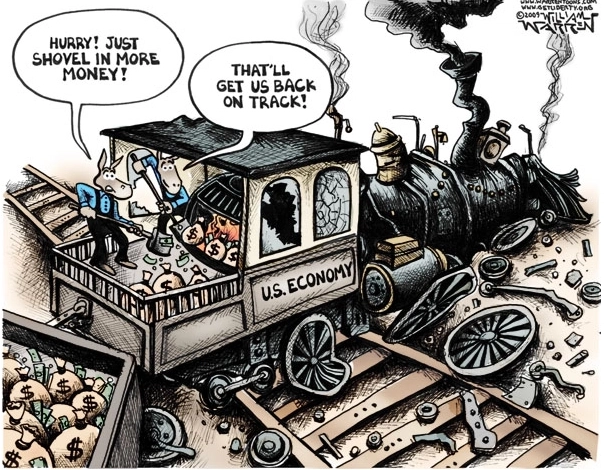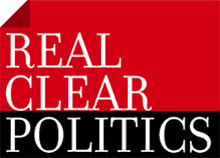July 14, 2022
Permission to republish original opeds and cartoons granted.
Inflation cracks 9.1 percent, highest since 1981, as imminent recession looms

By Robert Romano
Consumer inflation reported by the Bureau of Labor Statistics ticked up to 9.1 percent the past 12 months, the highest since 1981, in what has to be a crushing blow to any chances of avoiding a recession in the U.S. this year.
Food is up 10.4 percent unadjusted the past twelve months.
Energy is up 41.6 percent.
Gasoline is up 59.9 percent.
Electricity is up 13.7 percent.
Piped natural gas service is up 38.4 percent.
Shelter is up 5.6 percent.
Transportation is up 8.8 percent.
Medical care commodities are up 3.2 percent, and medical care services are up 4.8 percent.
You get the picture. All of that comes in just the past year. In 2021, inflation was largely correcting from near-deflationary conditions in 2020. No longer. In 2022, the story are price increases not seen in the U.S. for more than 40 years coming on the heels of the continued supply crisis and food and energy shortages.
Making matters worse, producer inflation increased 11.3 percent the past twelve months, as the increasing costs on employers will continue to weigh on labor markets that are already showing signs of contraction.
In addition, increasing interest rates are still nowhere near real inflation rates, with 10-year treasuries still at 2.9 percent. The effective federal funds rate at the moment is just 1.58 percent, according to the New York Federal Reserve.
As a result, interest owed on debt — a mechanism for removing dollars from the financial system — have come nowhere near close to sucking all of the additional dollars that were created by Covid stimulus actions by Congress and the Federal Reserve.
The national debt has increased by $7.3 trillion since Jan. 2020 to $30.5 trillion, of which the Fed monetized half, or $3.4 trillion, by increasing its share of U.S. treasuries to a record $5.7 trillion.
As a result, the M2 money supply has increased by $6.4 trillion to $21.75 trillion, a 41 percent increase. More than 90 percent of every new dollar of debt was paid for by printing it.
The inflation is little wonder. And neither are its impacts.
The news comes as 58 percent of Americans say America is already in a recession, according to the latest Economist-YouGov poll, despite continued happy talk from the Biden administration.
Just in June, President Biden was saying that a recession this year was “not inevitable.”
Adding to the misery, 44 percent saying the prices of goods and services was the best indicator of a recession and 57 percent saying the current inflation is impacting their lives “a lot.”
All this has to also be very bad news for Congressional Democrats hoping to hold onto meager majorities in the House and Senate in the November midterms.
Republicans still lead the average of national generic Congressional ballot polls taken by 1.9 percentage points, 46 percent to 44.1 percent, according to RealClearPolitics.com. In an average year in midterm elections dating back to 1906 through 2018, the party that occupies the White House usually loses on average 31 seats in the House, and about three seats in the Senate. If that happens, Republicans should easily reclaim both the House and the Senate this year.
Add the inflation to the mix, and this November, the American people will get to register their approval or disapproval for the state of the economy. That usually impacts the incumbent party. The question is by how much. Stay tuned.
Robert Romano is the Vice President of Public Policy at Americans for Limited Government Foundation.
To view online: https://dailytorch.com/2022/07/inflation-cracks-9-1-percent-highest-since-1981-as-imminent-recession-looms/

Biden’s inflation wrecks economy
Real weekly earnings down 4.4 percent.
July 13, 2022, Fairfax, Va.—Americans for Limited Government President Rick Manning today issued the following statement on the latest inflation data:
“President Biden's continued wrecking of the U.S. economy is evidenced by prices going up 1.3 percent in June and 9.1 percent for the past twelve months. Real wages after inflation as calculated declined by a full 1 percent in June alone, and dropped a whopping 3.6 percent over the past year. Even worse, employers are scaling back hours by 0.9 percent over the past year, making weekly average earnings or take-home pay 4.4 percent less than they were a year ago. Whether the hours are being scaled back due to the supply chain failures, slack demand, or both, this may indicate that the robust jobs economy may be at its end because people don’t pay people to stand around.
“A desperate Biden is meeting with the Saudis today to try to convince them to open their oil spigots, even as he has closed America's while selling our Strategic Oil Reserve to China. The one good thing that could come from the Biden-Saudi meeting is that it is rumored that Hunter Biden may be joining the new Saudi-backed LIV professional golf tour if the price is right.”
To view online: https://getliberty.org/2022/07/bidens-inflation-wrecks-economy/


Sean Trende: Republicans Are Favored to Win the Senate
By Sean Trende
Recently there has been a spate of stories about Republicans’ difficulties in taking over the Senate. These analyses typically focus on candidates’ poor polling numbers in key states and the weakness of the Republican recruiting class.
These aren’t absurd analyses; I’ve referred to the battle between the overall electoral environment and Republican candidate quality as “the irresistible force versus the immovable object” in previous columns. Had the Republican Party fielded its A-team in states like Georgia, Pennsylvania and Arizona, we probably would not be talking about Democrats even having a shot at retaining the Senate.
At the same time, we shouldn’t get carried away. While Republican candidate quality is an issue, good analysis should not lose sight of the fact that environment matters as well, and probably more so these days. President Joe Biden’s job approval is 37.7% in the RealClearPolitics Average, a mark reached only briefly by former President Donald Trump in August and December of 2017, and never touched by former President Barack Obama. While the map isn’t as favorable for Republicans as it will be in 2024, it isn’t unfavorable, either.
To see this best, let’s consider the races on an individual basis. Republicans need to net just one seat to win control of the Senate. Right now, Democrats have two realistic targets: Wisconsin and Pennsylvania. (Others, like Missouri and North Carolina, probably only come into play if the environment shifts in a dramatically favorable way for Democrats.) In Wisconsin, incumbent Senator Ron Johnson is a poor fit for the state ideologically. In Pennsylvania, Republicans nominated Dr. Mehmet Oz, who is most famous for dispensing sometimes-questionable medical advice on the Oprah Winfrey show, and who resides in a multi-million dollar home in New Jersey. This is compounded by the fact that Democrats have nominated Lt. Gov. John Fetterman, who doesn’t code as an East Coast progressive and who may be able to peel off working class voters in the state. Also, if we are being honest, Oz’s dual Turkish citizenship is unlikely to help him here.
But let’s also be honest about the daunting nature of the task facing Democrats. Both Pennsylvania and Wisconsin have been, on average, two points more Republican than the country as a whole in presidential elections. As elections analyst Harry Enten has pointed out, since 1982 the president’s party has defeated one incumbent senator in 87 attempts in such races (GOP Sen. Lauch Faircloth lost in 1998). But in that election, President Bill Clinton’s disapproval was roughly where President Biden’s approval sits today. Maybe Johnson is a special case, and there’s always a chance he loses. But we should probably start with a strong bias against it happening.
The president’s party has performed better in open seats that lean toward the opposition in presidential elections, but even then they are just 3 for 35 in the past 40 years. Republicans won an open seat in Minnesota in 2002, while Democrats won the Indiana Senate seat in 1998 and held the West Virginia Senate seat in 2010. But these three pickups all involved some combination of strange circumstances (the death of Sen. Paul Wellstone shortly before the election in 2002), an extremely popular president (1998 and 2002), or unusually strong candidates for the opposition (Evan Bayh, Joe Manchin, and, arguably, Norm Coleman). We might posit that Fetterman qualifies as an unusually strong candidate, but that remains to be seen; his endorsement of Bernie Sanders and his health issues are potential minefields for him to navigate.
In any event, it isn’t impossible for Democrats to flip one of these seats. It would just be unusual, especially with a president whose job approval sits in the 30s, and we should treat the possibility as such.
Democrats then have the task of defending three clearly vulnerable seats. Another one, in New Hampshire, is in some jeopardy, but probably doesn’t fall unless at least two of the other three seats also flip (Colorado and, to a much lesser degree, Washington State, could also come into play in the fall, but are unlikely to do so unless the previous seats are lost). Two of these states – Arizona and Georgia – have PVIs (Partisan Voter Index, which measures how each district or state performs at the presidential level compared to the nation as a whole) that lean toward Republicans, while a third (Nevada) has no lean in either direction. The president’s job approval in these states likely mirrors his national job approval; this means that a successful Democratic candidate is going to have to convince about one in six voters who don’t approve of the president to nevertheless pull the lever for the Democratic Senate candidate.
That’s a tall order, especially in Nevada, where Republicans have a reasonably good, if not spectacular, candidate in former Attorney General Adam Laxalt. Laxalt hails from a famous Nevada family, and is a capable enough politician that he lost the gubernatorial race by just four points in the solid Democratic year of 2018. He’s a candidate that is at least at the Mendoza line in an environment where Mendoza-line candidates should win.
That leaves Georgia and Arizona. Former Heisman Trophy winner Herschel Walker is a weak candidate with a penchant for outlandish comments, and Sen. Raphael Warnock is a charismatic incumbent. But this is still a seat that Warnock barely won against another weak candidate in a low turnout 2020 runoff, and he will have to convince a large number of voters who disapprove of the president to vote for him. Arizona is an under-polled race with a late primary. We don’t yet know what kind of candidate Blake Masters, the seemingly likely victor of the GOP primary, is going to be, although recent comments about the possibility that the Jan. 6 attack on the Capitol was an FBI false flag operation aren’t particularly promising. But again, all he has to do to win is convince about 80% of the Arizona voters who disapprove of President Biden to vote for him.
In short, the battle for the Senate comes down to Democrats’ ability to win at least three of four seats that would likely be highly competitive if President Biden’s job approval were about ten points higher than it is today. But in a situation where Senate outcomes correlate heavily with presidential job approval in the state, that’s a tough row to hoe. While we should give more than a cursory nod to the possibility that Democrats will hold the Senate (unlike the possibility that Democrats will hold the House, which is barely worth that nod), we should also say with some confidence that Republicans are the favorites to win.
Probably the best counter-argument is that our high levels of polarization insulate Democrats from Biden’s job approval. In other words, there are voters who may disapprove of the job the president is doing, but will nevertheless vote Democratic. We saw this in 2008, where Republican candidates ran far ahead of President Bush’s job approval in many states. Republican voters may have recognized the poor job he was doing, but in the end, they were still Republicans.
There’s no doubt that we’ve reached that point, as most Democratic Senate candidates are running ahead of Biden’s job approval right now. We’ve become much more polarized since 2008, and Democratic candidates in these states probably have a higher floor than we might have seen 10 years ago. But this is a two-way street; Republican candidate quality won’t matter as much as it might have a decade ago either.
What we’re probably seeing in the favorable polling for Democratic Senate candidates right now is what we see in almost every wave and semi-wave election: The wave doesn’t form until fairly late in the season. In 2006, Democratic candidates in Washington, Maryland, and New Jersey hadn’t yet put away their Republican challengers. (In fact, Republican Tom Kean Jr. led in the polling in New Jersey until September.) In 2010, Republican leads in states like Ohio, New Hampshire, North Carolina, and Florida all suggested competitive races; Republicans won these states by double digits. In 2014, there was genuine doubt about the fate of the Senate throughout the summer. Even in 2018, there was genuine uncertainty about the fate of Republican senators in vulnerable states like Nevada and Arizona until the end; in both those races, Republican candidates won almost exactly what the polling averages suggested they should win (which also happened to be President Trump’s job approval in the states according to exit polls). But the undecideds broke heavily in the Democrats’ favor.
Again, maybe this time is different. The “candidate quality” and “polarization” arguments above are non-trivial, even if they are also in tension with each other. It’s possible this time really is different. But “this time it’s different” has a poor track record.
To view online: https://www.realclearpolitics.com/articles/2022/07/13/gop_likely_to_take_senate_but_its_far_from_a_lock_147883.html


